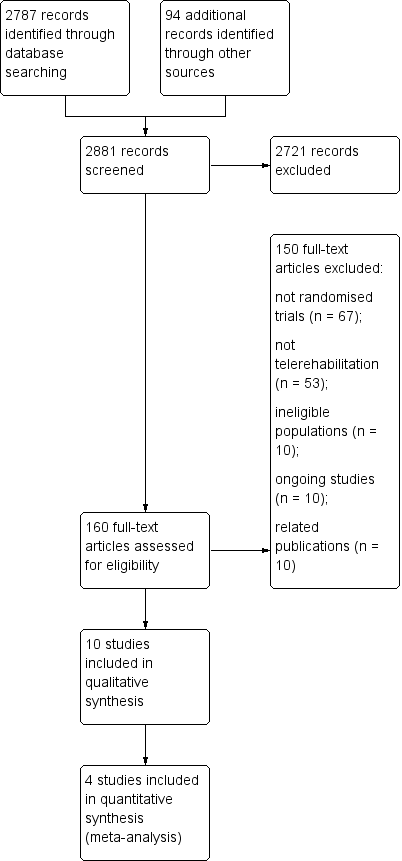| Study | Intervention | Comparison | Time after stroke | Country of study |
| Boter 2004 | Case management via 3 telephone calls and a home visit up to 24 weeks after discharge from an acute hospital following stroke | Usual care | Not reported; however, intervention was provided on discharge from acute facility | The Netherlands |
| Carey 2007 | Upper limb therapy targeting finger and wrist movements provided via a computerised programme in which explicit feedback on performance was provided. Regular teleconferencing occurred between participant and therapist | Upper limb therapy targeting finger and wrist movements provided via a computerised programme whereby explicit feedback on performance was not provided. Regular teleconferencing occurred between participant and therapist | Chronic phase | USA |
| Chumbler 2012 | A programme designed to improve the person's functional mobility administered via televisits, use of an in‐home messaging device and 5 telephone calls over a 3‐month period | Usual care | Subacute phase | USA |
| Deng 2012 | Lower limb therapy targeting ankle movements provided via a computerised programme in which explicit feedback on performance was provided. Teleconferencing was used regularly, and performance data were emailed to the therapist | Lower limb therapy targeting ankle movements provided via a computerised programme whereby explicit feedback on performance was not provided. Teleconferencing was used regularly, and performance data were emailed to the therapist | Chronic phase | USA |
| Forducey 2012 | A total of 12 therapy sessions (occupational therapy and physiotherapy) were conducted via a desktop videophone. Interventions included education, retraining of self care, functional mobility and posture, home modifications and therapy to improve function in impaired limbs | The same intervention programme was delivered face‐to‐face | Not reported | USA |
| Huijgen 2008 | Upper limb therapy using the Home Care Activity Device (computer‐based programme) for 1 month | Usual care and generic exercises were provided by a physician | Chronic phase | The Netherlands |
| Mayo 2008 | Case management intervention provided via home visits and telephone calls for 6 weeks following discharge from acute care | Participants were instructed to make an appointment with their general practitioner | Acute phase | Canada |
| Piron 2008 | Upper limb therapy that was delivered using a virtual reality programme at home and supplemented by videoconferencing | Upper limb therapy that was delivered using a virtual reality programme and conducted in the clinic setting | Chronic phase | Italy |
| Piron 2009 | Upper limb therapy that was delivered using a virtual reality telerehabilitation programme and that took place in the home | A programme of conventional upper limb exercises | Chronic phase | Italy |
| Smith 2012 | An intervention to support the caregivers of stroke survivors by enhancing knowledge, skills and coping. Delivered via email, online chat sessions and online resources | Participants had access to some of the online resources | Not reported | USA |






